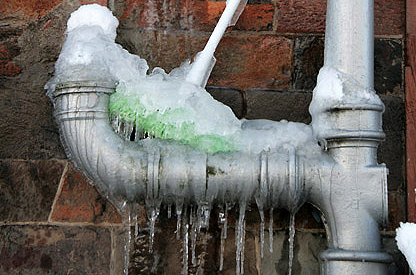We have found this article relating to Winter Plumbing Precautions: Preventing Frozen Pipes down the page on the web and felt it made sense to share it with you on my blog.

Winter can wreak havoc on your plumbing, particularly by freezing pipes. Right here's exactly how to avoid it from occurring and what to do if it does.
Introduction
As temperatures decline, the threat of icy pipes increases, possibly bring about costly fixings and water damages. Understanding just how to avoid frozen pipelines is important for property owners in cold environments.
Prevention Tips
Shielding susceptible pipes
Cover pipes in insulation sleeves or make use of heat tape to shield them from freezing temperatures. Concentrate on pipelines in unheated or outside locations of the home.
Home heating methods
Keep indoor spaces effectively heated up, particularly areas with pipes. Open up cupboard doors to enable cozy air to distribute around pipelines under sinks.
How to identify icy pipelines
Seek lowered water circulation from taps, unusual odors or sounds from pipelines, and noticeable frost on exposed pipes.
Long-Term Solutions
Structural changes
Take into consideration rerouting pipelines away from exterior walls or unheated areas. Add extra insulation to attic rooms, cellars, and crawl spaces.
Upgrading insulation
Invest in high-grade insulation for pipelines, attic rooms, and walls. Proper insulation helps keep constant temperatures and decreases the risk of icy pipes.
Safeguarding Exterior Plumbing
Garden pipes and outdoor taps
Disconnect and drain pipes garden hose pipes prior to wintertime. Install frost-proof spigots or cover exterior faucets with shielded caps.
Understanding Icy Pipes
What creates pipelines to freeze?
Pipelines freeze when exposed to temperatures listed below 32 ° F (0 ° C) for expanded durations. As water inside the pipelines ices up, it increases, taxing the pipeline wall surfaces and possibly causing them to burst.
Risks and damages
Icy pipelines can bring about supply of water disturbances, residential or commercial property damage, and expensive repairs. Burst pipelines can flooding homes and trigger comprehensive structural damages.
Indications of Frozen Water Lines
Identifying icy pipelines early can prevent them from bursting.
What to Do If Your Pipelines Freeze
Immediate actions to take
If you suspect icy pipes, maintain faucets open to eliminate stress as the ice melts. Make use of a hairdryer or towels taken in hot water to thaw pipelines gradually.
Final thought
Preventing icy pipelines requires aggressive procedures and quick feedbacks. By comprehending the causes, indications, and preventive measures, home owners can safeguard their pipes during cold weather.
6 Proven Ways to Prevent Frozen Pipes and Protect Your Home
Disconnect and Drain Garden Hoses
Before winter arrives, start by disconnecting your garden hoses and draining any remaining water. Close the shut-off valves that supply outdoor hose bibs and leave the outdoor faucet open to allow any residual water to drain. For extra protection, consider using faucet covers throughout the colder months. It’s also important to drain water from any sprinkler supply lines following the manufacturer’s directions.
Insulate Exposed Pipes
Insulating your pipes is an effective way to prevent freezing. Pipe insulation is readily available at home improvement stores and is relatively inexpensive. Pay close attention to pipes in unheated areas such as the attic, basement, crawl spaces, or garage. Apply foam insulation generously to create a buffer against the cold. You can also wrap your pipes in heat tape or thermostat-controlled heat cables for added warmth.
Seal Air Leaks
Inspect your home for any cracks or openings that could let in cold air. Seal any holes around the piping in interior or exterior walls, as well as the sill plates where your home rests on its foundation. Additionally, make sure to keep your garage door closed unless you’re entering or exiting. Leaving it open creates a significant air leak that can lead to frozen pipes.
Allow Warm Air Circulation
During cold snaps, it’s essential to allow warm air to circulate evenly throughout your home. Leave interior doors ajar to promote better airflow. Open kitchen and bathroom cabinets to help distribute heat consistently around the rooms. If you have small children or pets, be sure to remove any household chemicals or potentially harmful cleaners from open cabinets for safety.
Let Faucets Drip
A small trickle of water can make a big difference in preventing ice formation inside your pipes. When temperatures drop significantly, start a drip of water from all faucets served by exposed pipes. This continuous flow helps prevent the water from freezing. Additionally, running a few faucets slightly can relieve pressure inside the pipes, reducing the chances of a rupture if the water inside does freeze.
https://choateshvac.com/6-proven-ways-to-prevent-frozen-pipes-and-protect-your-home/

I hope you liked our excerpt about Winter Plumbing Precautions: Preventing Frozen Pipes. Thanks so much for spending some time to read through our blog. For those who enjoyed our blog post please don't forget to pass it around. I am grateful for being here. Return soon.
Automated Marketing